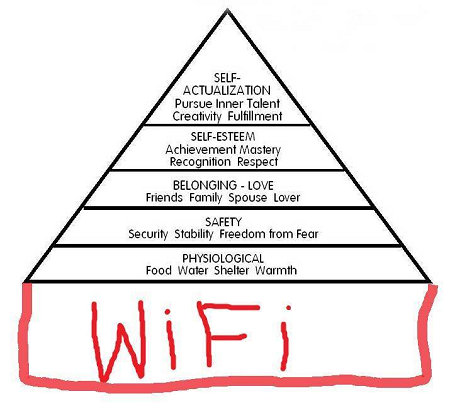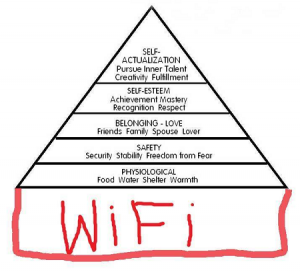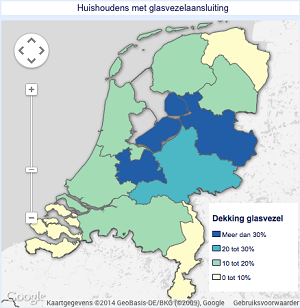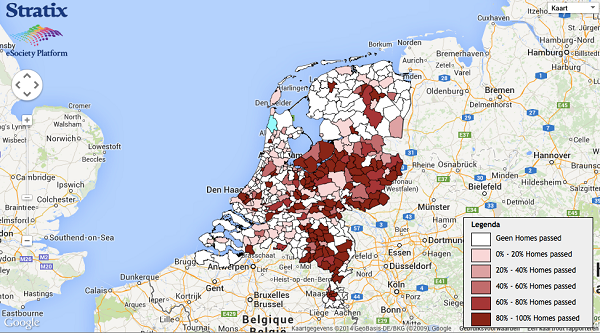
Why is the market so rigid and the government so reluctant?
 There is a new pyramid of Maslov trending on social media, where wifi is considered more basic to life than food, shelter and safety. NGA (next generation access) is considered essential, not only for watching tv, gaming and entertainment, but more importantly: for healthcare (being ably to live independently for a longer period of time), for education (contemporary and appealing), business (websites, upload facilities, accessibility and videoconferencing) and last but not least for (local) government and organizations to administer buildings, public space and infrastructure in a smarter and cheaper way.
There is a new pyramid of Maslov trending on social media, where wifi is considered more basic to life than food, shelter and safety. NGA (next generation access) is considered essential, not only for watching tv, gaming and entertainment, but more importantly: for healthcare (being ably to live independently for a longer period of time), for education (contemporary and appealing), business (websites, upload facilities, accessibility and videoconferencing) and last but not least for (local) government and organizations to administer buildings, public space and infrastructure in a smarter and cheaper way.
Considered this way, it’s actually a service that is already essential, just like water and electricity. And it will only increase in importance the next few years if you look at the development of the-Internet-of-Everything. But what do we mean by “fast internet” (NGA)? Three different forms:
- Cable: slow upload facility, fast download, no open network (no choice in providers)
- Glass: up and download fast, open network (ample choice in providers)
- 4G: wireless so perfect on the road, but at slower speed, not so much choice in providers but still emerging
 I consider glass to be potential for the future, since cable is hardly able to increase any further (with today’s eyes). Besides, glass can be an able carrier for 4G and 5G in the future, as a grid for 4G transmitters. However, this is still very premature in Holland. I do find it peculiar that fiberglass is installed while being paid for by the end user only. When we look at the map of our country by region, then we see that mid-east Holland takes a lead. Especially the “shrink area’s” are behind when it comes to connection.
I consider glass to be potential for the future, since cable is hardly able to increase any further (with today’s eyes). Besides, glass can be an able carrier for 4G and 5G in the future, as a grid for 4G transmitters. However, this is still very premature in Holland. I do find it peculiar that fiberglass is installed while being paid for by the end user only. When we look at the map of our country by region, then we see that mid-east Holland takes a lead. Especially the “shrink area’s” are behind when it comes to connection.
At first sight, the Randstad (western Holland) seems okay. However, if we look at municipalities it really scares me: very few people have been able to actually connect to fiberglass! In Amsterdam and Utrecht it’s only about 15%, and Rotterdam and The Hague only 5% … Do the cable companies have such a monopoly? Or is there a lack of a fiberglass network in the first place? Further research showed me that lack of a comprehensive network of glass makes it impossible to get yourself connected… Do we see a huge problem here?
 I also find it fascinating to see the difference between Utrecht, Flevoland, Gelderland and Overijssel, and the shrinking area’s Zeeland, Limburg and Groningen. How is it possible that the first three regions are doing so well? Try a Google search and you will find many initiatives to get houses and businesses connected. But not in the shrinking area’s…
I also find it fascinating to see the difference between Utrecht, Flevoland, Gelderland and Overijssel, and the shrinking area’s Zeeland, Limburg and Groningen. How is it possible that the first three regions are doing so well? Try a Google search and you will find many initiatives to get houses and businesses connected. But not in the shrinking area’s…
Bron: Stratix
In my view, the regional departments and local governments let pass a great chance. Again, not only to give people the opportunity to watch movies or for gaming, but mostly to enhance the quality of life in cities, villages and countryside. And of course for cheaper and smarter administration of buildings, public space and infrastructure.
So, all of you in (local) government, providers and institutions: look beyond the next 5 years. Invest, and do this together. Involve the end users as well: citizens, entrepreneurs, businesses and social partners.

Leave a reply